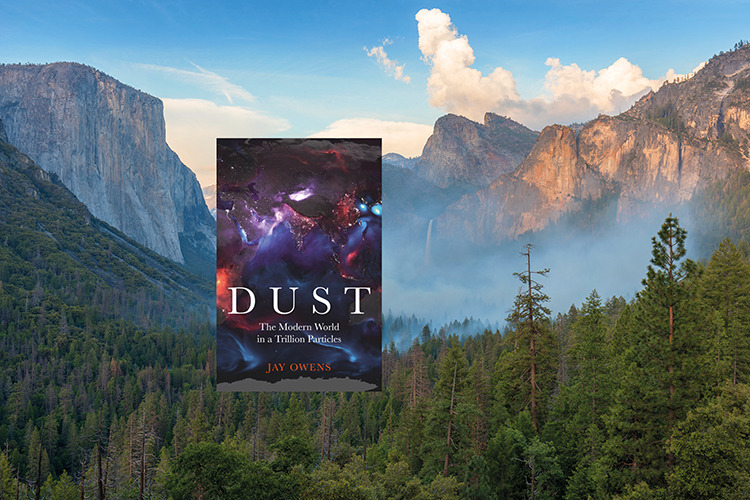
Geographer and media researcher Jay Owens explores the mudane modern marker of the world, and how it can cause planetary problems
Review by Bryony Cottam
Recently, a group of scientists set about searching for evidence that we’ve entered a new epoch: the Anthropocene. They dug up mud from the world’s deepest lakes and cut cores from remote glaciers, looking for tiny anthropogenic markers: soot from combustion processes, microplastic particles and artificial radionuclides – the deadly fallout from thousands of nuclear-weapons tests. Trapped between layers of sediment and ice, all this human-made dust represents a point in time when we began to significantly alter the planet in ways that will still be visible far into the future. Whether or not you agree that we’ve entered a new geological time period (perhaps you consider our impact on Earth a mere blip in its 4.5-billion-year history), there’s no denying that dust is a marker of our modern world, as Jay Owens reveals in her new book.
Owens, a geographer and media researcher, first introduces dust as an unthreatening, even trivial, subject – it’s the dust bunnies that gather in the unlived-in corners of our homes, the soft, fine powder that collects on old books and on top of the wardrobe. It’s so totally mundane, says Owens, that nobody thinks about what it might be doing or where it should go. We should. These ‘tiny flying particles’ – Owens defines them as typically sub-millimetre in scale – are weaselling their way into our homes, and even our lungs and blood, precisely because of their size. They may be tiny, says Owens, ‘but the problems they usher in their wake are planetary’.
Everything has the potential to become dust, given enough time. Much of it is natural, consisting of everything from desert sand and volcanic ash to pollen, skin and hair. ‘Dust is also a critical component of atmospheric processes, ocean systems, and biological and human processes and systems too,’ writes Owens. But Dust focuses largely on the dust created by us, by our continued burning of wood and fossil fuels, by the deforestation, industrial agriculture and unsustainable water practices that continue to drive desertification and the degradation of already-arid landscapes.
Owens’ first real encounter with this kind of dust came during a road trip through California in 2015, when a plume of smoke emanating from the already fire-ravaged Sierra National Forest choked the nearby valleys for days. Here, we learn how the nascent city of Los Angeles drained the water from the neighbouring Owens River, leaving the once lush valley a barren desert. In the 1940s, when land that had once sustained orchards and vegetable gardens was used as a Japanese American internment camp, one internee described the situation as abominable. ‘We slept in the dust, we breathed the dust; and we ate the dust.’
From California, Owens takes us on a tour of some of the dustiest places on Earth, often vividly and in person. As she drives through the Oklahoma Panhandle – commonly known as the Dust Bowl – taking in the incomprehensibly large grain silos and machinery that dominate the wide-open landscape, she reflects on how the first of the dust storms that swept through in 1935 must have appeared, like a ‘roiling mass of darkness two thousand feet high’. In Uzbekistan, she recalls the repellent odour of the desiccated Aral Sea – once the world’s fourth-largest lake – a mix of rotten eggs and a strange, almost sweet smell that reminds Owens of ‘something sick’. The downside of Owens’ engaging travel writing is that sometimes the book’s focus feels a little skewed towards the locations where she has travelled; we return to a second chapter on the Owens Valley later in the book.
One fascinating chapter, sandwiched somewhat awkwardly between a short description of 19th-century land grabs in the American West and Owens’ visit to a two-day Uzbek techno festival, offers a brief history of the 20th century’s new obsession with cleanliness that really began to emerge – Owens says – as our homes accumulated more stuff for dust to settle on.
The rise of consumerism made dust synonymous with dirt and spawned a litany of manuals and magazine articles on how to keep a home clean, a task that inevitably fell on the lower classes, women and minorities. From this, we see innovations such as the vacuum cleaner and, later, the clean room – technology that would enable the development of spacecraft and nuclear weapons.
Earlier this year, scientists finally selected a location that could represent the beginning of the Anthropocene. The choice, Crawford Lake in Ontario, had been a strong contender – its unusual depth meant its exceptionally well-preserved sediment contained strong signals of radionuclides from atomic detonations around the world. At least half of the estimated 2.4 million deaths from radioactive dust haven’t happened yet, writes Owens, ‘but the particles produced by these explosions haunt our world still, and slowly and randomly exert their consequences’. Dust, we discover, really isn’t a trivial subject at all.




